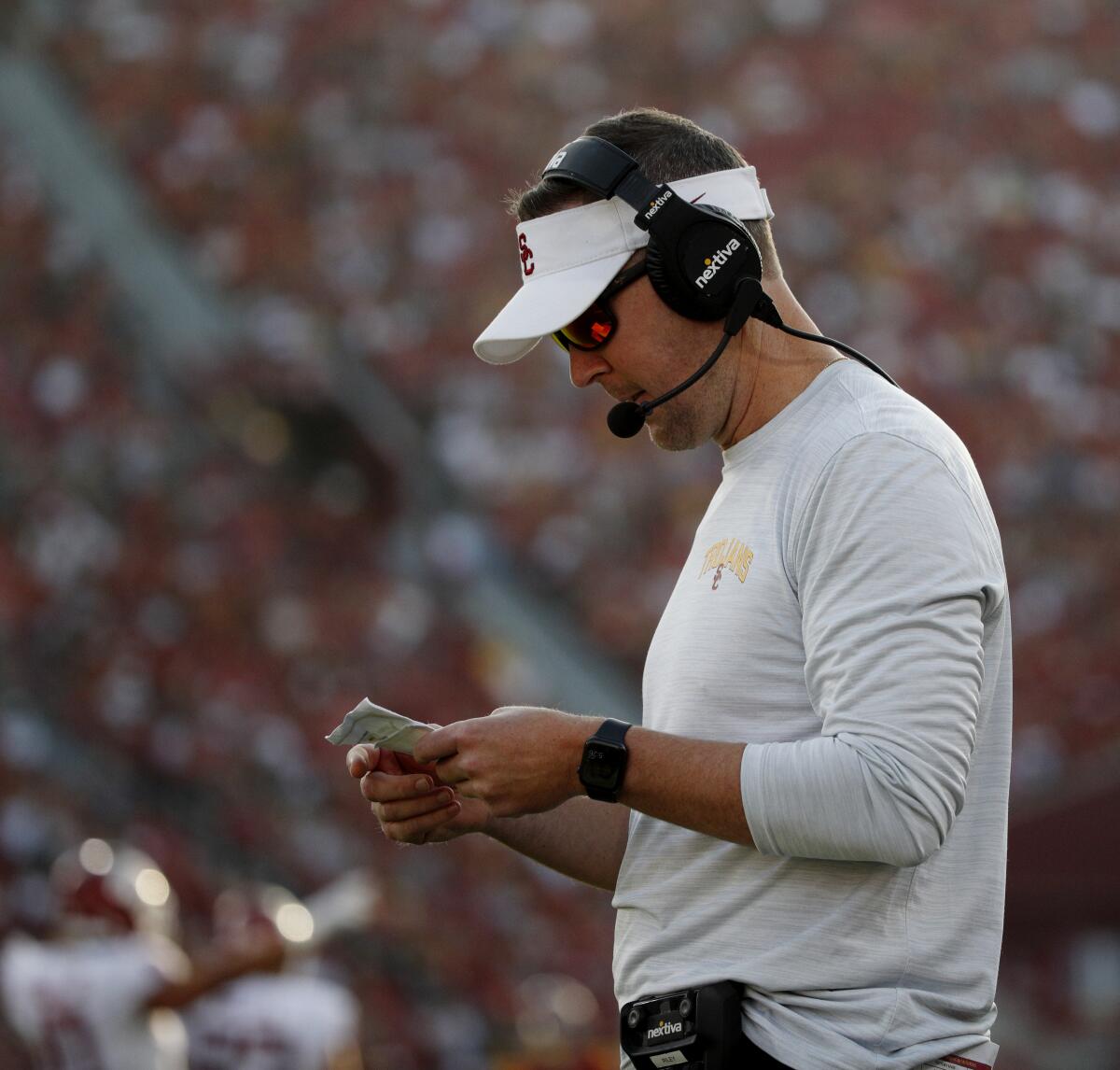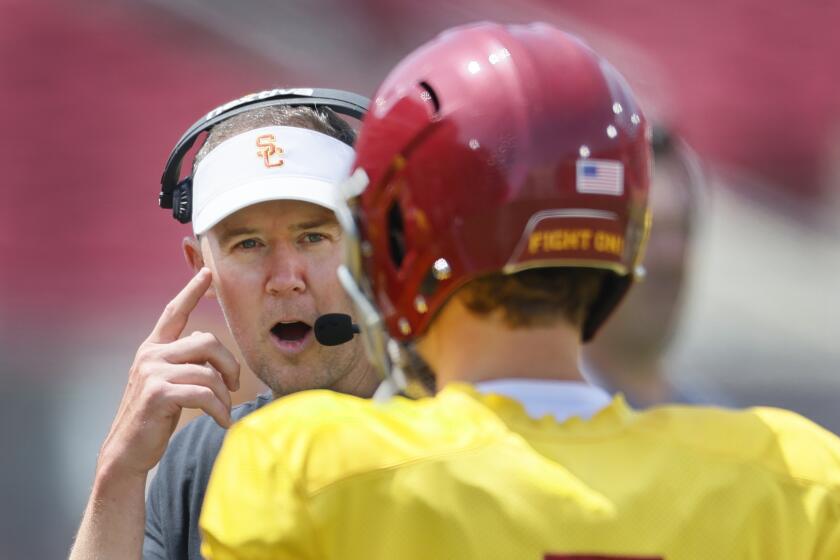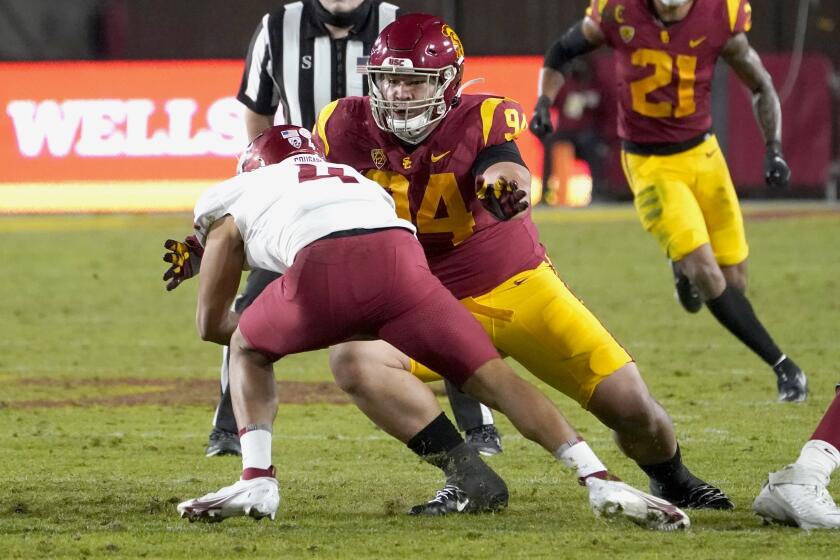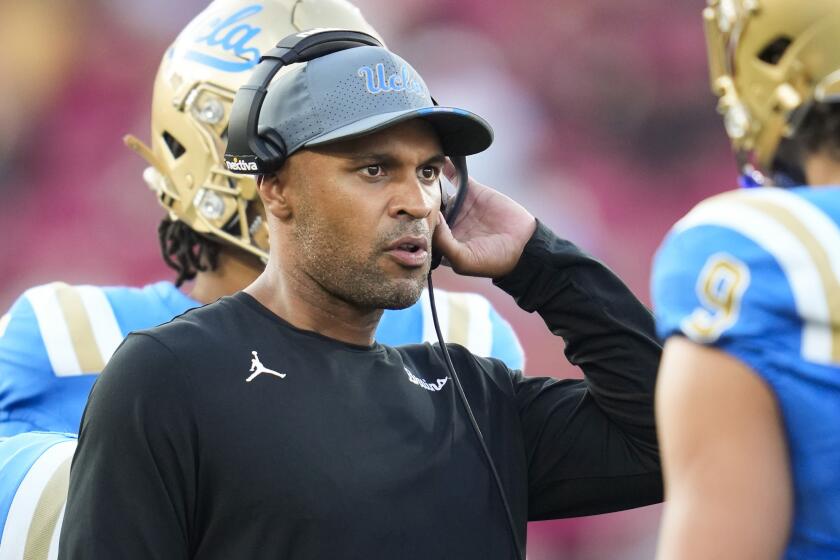USC tests new helmet audio, but ‘cat and mouse’ game protecting signals continues

- Share via
The gray screen, large enough to obstruct the opposing sideline’s view of USC coach Lincoln Riley, wasn’t exactly subtle. But against Utah, a team he knew to be adept at intercepting sideline signals, Riley decided to take additional security measures. So last October, on the heels of Michigan’s sign-stealing scandal, out came that gray screen, held in front of Riley like a beacon of passive-aggressive football paranoia.
To Utah coach Kyle Whittingham, its presence alone felt like a provocation.
“If your signals are being stolen in-game, that’s your fault,” he later told reporters.
Riley, meanwhile, insisted the screen was just a necessary precaution when sign stealing was still such a constant in the college game.
USC coach Lincoln Riley said the Trojans have improved in every area and the suggestion the team won’t compete in the Big Ten is uninformed.
“Just a way to try and protect a few of the things that we do,” Riley said.
Of course, both coaches knew there was a better way — one that didn’t involve silly signal deciphering or a low-level staffer following them around with a comically large screen. Most college coaches had been calling for in-helmet communication for years, similar to what the NFL has had since 1994. But the NCAA football playing rules committee had dragged its feet on doing anything about it, for reasons reportedly related to competitive equity and helmet manufacturer liability.
Riley couldn’t understand the hold-up, when he was asked about it last October. “It’s a remarkably easy fix,” he said of in-helmet communication. “It’s amazing we haven’t gotten there to this point yet.”
A sign-stealing scandal, it turns out, has a way of suddenly shifting priorities. By April, the NCAA approved a rule change allowing for one player on each side of the ball to have use of a radio in their helmet, each denoted to referees by a green dot. Like in the NFL, that communication will be cut off with 15 seconds remaining on the play clock or when the ball is snapped, whichever comes first.
USC football coach Lincoln Riley touted signs of progress and support for the Trojans as they open preseason camp Friday morning.
For such a simple fix, it could have lasting implications on the college game, from the pace of play to coaches’ approach to late audibles. What it almost certainly won’t do, however, is put a stop to sign stealing.
“It doesn’t really help,” Penn State coach James Franklin said at Big Ten Media Day. “I think a lot of people that passed the rule think it did. But if you’re running a no-huddle offense and can talk to the quarterback, how do you get the information to the wideouts that are 53 yards apart from each other? You’re still going to have to signal to them.”
Riley and his staff have been experimenting since spring in search of best practices for their new means of pre-play communication. He wouldn’t offer up many details about that plan, other than to say they’d change on a weekly basis. He said there was “a bit of cat-and-mouse” to the strategy behind it.
“Called offensive and defensive plays for a long time without it. So it’s an adjustment,” Riley said. “We’re starting, I think, to settle in on what role it’ll have for us on both sides of the ball. Obviously, what players you’re going to use, how much communication — there’s obviously a lot of strategy to it. It’s been fun test driving it. We went in thinking we might use it a couple ways, and we were right about some of the ways, but we’ve certainly made adjustments along the way to try and make it more efficient. But it’s a part of the game now. You’ve got to find a way that’s going to help make your team and your program better.”
Lincoln Riley wasn’t sure out-of-shape Kobe Pepe would make it at USC, but the defensive lineman has transformed himself into a strong lineman.
That starts at the quarterback position, where Miller Moss is still getting used to having his coach’s voice in his ear before the play.
“Someone is talking to you, but you can’t talk back to them,” Moss said, before cracking a smile. “Which Coach Riley might be happy about.”
But offense isn’t the only place where new ways of communicating can be of strategic use. Linebacker Easton Mascarenas-Arnold, who transferred to USC from Oregon State in the offseason, has primarily worn the green dot on defense so far for the Trojans.
Camped in the middle of the defense at the Mike linebacker position, he has the most direct line to communicate calls to every level of the defense.
The responsibility is less straightforward on that side of the ball. Defenses are built to react to calls on the fly. Personnel subs in and out. It’s a bit more chaotic than an offense looking to a quarterback for its cues. That’s meant getting multiple players comfortable with the new communication.
In D’Anton Lynn, USC has a defensive coordinator well accustomed to that chaos. Lynn spent nine seasons in the NFL before switching to the college game last year at UCLA, where he realized how much he’d relied on the headsets, pre-play. Being without in-helmet communication for his first season as a defensive coordinator was “a big adjustment,” he said.
USC hired UCLA defensive coordinator D’Anton Lynn to run its defense following Alex Grinch’s midseason dismissal.
“It’s helped us a lot so far,” Lynn said of having it back.
Though, it won’t completely replace sideline signals, Lynn said. “We’ll still do a combination of both.”
Switching over from a signal-based system to one totally reliant on the headset in his helmet was definitely a hurdle at first for Moss. Minor issues came up throughout the spring, as he and Riley both got the hang of the new technology at their fingertips.
Those kinks in communication have since been ironed out. But Moss is still determined not to rely too much on the voice in his head to keep USC’s offense on track.
“I think it’s a good tool for us to operate more efficiently,” Moss said, “but it’s not a substitute for being prepared.”
More to Read
Go beyond the scoreboard
Get the latest on L.A.'s teams in the daily Sports Report newsletter.
You may occasionally receive promotional content from the Los Angeles Times.











